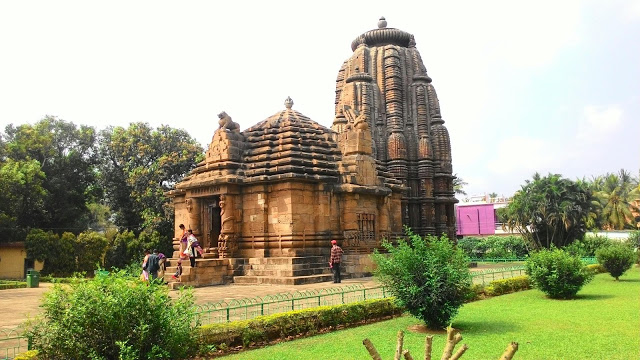Bhubaneswar is the city of old temples and having acquired this newfound fondness of visiting places of historical interest it is very tempting not to have a walk in to the rather interestingly named temple , Rajarani Temple.Why such a catchy name? Well thats a mystery. Situated in the old city just a couple of kilometres away from the Lingaraj temple the temple has been fenced amidst well maintained garden that has a straight footpath leading to the temple. To see a temple with city buildings around gives you the feeling of an ordinary shrine in your colony or neighborhood and given its smaller structure compared to the majestic Lingaraj acts as a alibi to the first-glimpse-analysis.
As you walk closer to let the image formed in your brain through your optic nerve gain enhancement in terms of definition and clarity , it takes no time to shred off your initially formed notions. The picture of ‘the temple’ in our childhood scrapbook is given the extra dimension ; hence to conceive a lively real-life monument out of the gallery. The plain strokes of brown on paper has given to yellowish and dull red complexion and so has the adhering particles of crayons to chiseled sandstones. The casually depicted designs has made the finest transformation to acute and crafty artwork of varying subjects which undoubtedly makes this rather common architectural monument special.
Built on a raised platform the temple has distinctly two parts – the frontal squared shaped jagmohana, as they call it, and at the rear end the long pyramidal vinama reflecting typical Kalinga architecture. As the historians say the temple dates back to mid 11th century AD believed to have been built by the Somavamsi kings. Many believe that central Indian temples owes their seeds of architecture to this piece of art. Talking of architecture , this very aspect arrested my eyes instantly – the ‘wow’ factor of the love-at-first-sight. The vivid depiction of the life of Shiva , his marriage to Parvati in the form of inexplicably brilliant sculptures coupled with several slender feminist characters in various roles and moods are well preserved and worth capturing. Internet will help you to get the background details of all the prominent mythological characters but unless you witness by yourself you cannot apprehend the amaze.
The most striking thing about this temple is being a shrine without any idol – something thats unusual in Hindu history of temples. The sanctum is empty , bereft of any platform that might had indicated the existence of some past idols presently removed . Even google could not give me the definite story behind this. The popular theory is that it is not related to any particular sect of Hinduism hence might hold its roots to Saivite origins. Unlike the exterior the interior lacks designs or artworks . Another obvious peculiarity lies in the name. How come it got such unique name? Neither it is in vicinity of any palace nor its structure is large enough to bear the weight-age of such a name. The local argurment transpires from the fact that the entrance is sculpted with naga(king) and nagina (queen) on both sides. But historians counters the derivation might have come from the foundation stones which were locally known as raja-rani- quite an intriguing fact indeed , definitely a research matter.
Regardless of its uncertain history and extent of historical significance compared to the Lingaraja or the famous Jaganath Temple of Puri , the mere visuals are enough to make this significant in the memory lane. The lack of idols or worship schedules , the absence of any extended courtyards , the small-scale structure, the sprouting congested urbanization in the immediate surroundings might prevent the full-fledged expression of the ‘marvel’ mental orgasm. But in no way it fails to be a treat to the eyes. If you come to visit Lingaraja an extra hour afforded to this place will definitely be an added bonus , a worthy inclusion to your repository.










